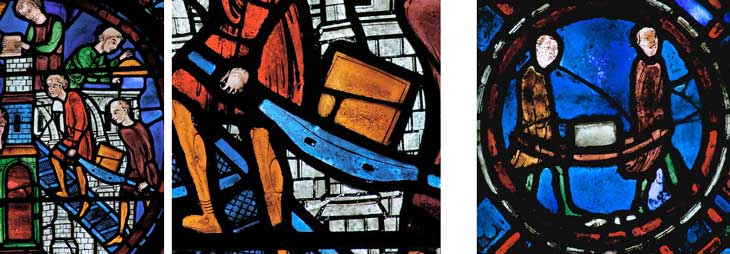To the questions that reach the rectorate of the cathedral – especially through the guides of the Visitor Service – we sometimes answer in images. The subjects are varied and sometimes highlight unsuspected aspects of the cathedral…
When I was a child, I was intrigued by a statement to the effect that wheelbarrows were not used on cathedral building sites. So how were the heavy stones transported to the foot of the scaffolding?
The legend of the wheelbarrow’s recent invention is quite tenacious. Several authors have attributed it to Blaise Pascal, misunderstanding a late 17th-century Parisian witticism. Our great man of science, who was an austere spirit, would surely have burst out laughing: he sometimes saw them rolling down the streets of Paris…
The difficulty with the wheelbarrow, even today, is that it requires loads to be broken whenever it’s impossible to roll – hence the installation of plank “paths” on building sites. At least until the 13th century, the most widely used method was the stretcher: two strong wooden bars, a platform and two carriers. Two fine examples can be seen in the cathedral’s stained glass windows, which are associated with the building trades. In the Charlemagne window (building a church in honor of St. James), laborers toil on a catwalk that climbs up the scaffolding. Some of the details are realistic, such as the bars on the walkway to prevent slipping, the reinforcement of the stretcher bars in the middle, and the two holes on each side to securely fasten the burden. Other details are totally unrealistic, such as the footbridge that reaches the base of the stained glass windows on the upper floor in a single sweep, some twenty meters high! In the stained glass window of Saint Silvestre, donated by the masons, a miniature panel is devoted to this transport of stones.

left: stained glass window of Charlemagne & detail of the stretcher – right: stained glass window of Saint Silvestre, donors
© NDC – fonds Gaud
The same process can be found in many 13th-century manuscripts, often depicting the construction of the Temple of Jerusalem. Here are two margin illuminations (manuscripts from the Alençon library and the Bibliothèque Sainte Geneviève – Paris) that resemble the Chartres stained-glass windows. This picturesque theme can also be found in 19th-century pastiches – such as this beautiful building site scene showing the variety of building trades, as well as 20th-century copies.

left: two illuminated margins (manuscripts from the Alençon library and the Bibliothèque Sainte Geneviève – Paris)
right: 19th-century pastiches
The first appearances of the wheelbarrow in manuscripts date from the 1240s/1250s: the example of the life of Saint Alban, produced in England by Matthieu Paris, is frequently cited. The wide distribution of this iconography over the following two decades suggests that the wheelbarrow was already fairly well known: we must avoid the mistake of trying to date its appearance too precisely. We know that artists often lag far behind when it comes to integrating certain technical evolutions: I remember a kindergarten, around 1985, in which the teacher invited students to draw… steam trains.
The wheelbarrow of the late Middle Ages is quite different from ours, and looks more like a wheeled stretcher: the tray is set very low and has a curved profile. This is how it appears in many 15th-century illuminations. Scottish carpenters have recently produced an interesting reconstruction.

left: English manuscript / middle: margin of a Touraine manuscript / right: reconstruction